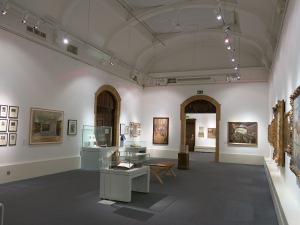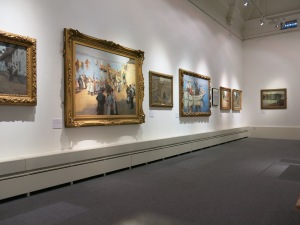It’s been nearly two months since the artworks for Stanhope Forbes’ England went back to their owners and one year since we began the Skills for the Future traineeships, so I have been reflecting on all that I have learned.
As part of evaluating the exhibition, I hosted a swap shop, introducing the trainees to the principles of front-end, formative and summative evaluation before we spent a few hours observing visitors to Stanhope Forbes’ England. From these observations and evaluating visitor numbers and the comments book we now know that:
- There were around 19,000 visitors to the building during the duration of the exhibition
- 81% of visitors came specifically for the Forbes exhibition
- 51% of visitors came from outside the WR postcodes
We also received some inspiring comments in the visitor book, including:
“Thank you for bringing this exhibition to Worcester”
“Excellent exhibition. Inspires me to find out more.”
“Chadding in Mounts Bay – one of the great paintings of the 20th century. A fine exhibition well worth the drive from Newlyn to Worcester!”
A particularly lovely moment in evaluating the exhibition came when one of the trainees observed two couples who came separately and did not know each other, but began to talk about the exhibition and then continued around the museum together. These types of comments and observations make me feel so proud of everything that Worcester City Art Gallery and Museum achieves and highlights what exhibitions can bring to the local community.
Evaluating my learning while working on Stanhope Forbes’ England has also filled me with pride, in both my own achievements and in the people I work with. I was offered a rare combination of freedom and support from the team here at MAG, which I believe significantly fast-tracked my learning. Curating Stanhope Forbes’ England offered me an in-depth understanding of the complex processes behind loans based exhibitions including project management; securing Government Indemnity insurance; arranging transportation and packaging; managing environmental conditions; planning an exhibition hang; writing interpretation, marketing materials and a companion publication; as well as giving public talks and tours.
I am aware what an incredible privilege this is at such an early stage in my career and the benefits I have gained do not only lie in this widened skills set, but have also had tangible results as I have been offered ongoing curatorial work at Museums Worcestershire. I have also been awarded a position on the British Arts Network’s Early Career Curators Group (supported by Arts Council England and Tate) for the next two years which includes a professional development bursary. I hope to use these opportunities to continue bringing great exhibitions to Worcester and to continue developing as a heritage professional.
Emalee Beddoes




